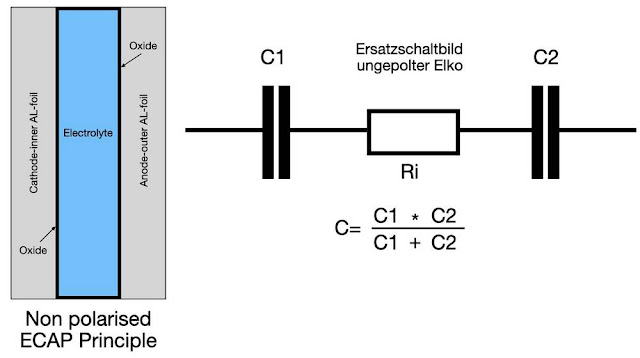HOW DOES AN ELECTROLYTIC CAPACITOR WORK?
STRUCTURE & FUNCTION OF AN ECAP
Electrolytic capacitors belong to the group of electro-chemical capacitors.
As is the case for all capacitors, the capacitance increases with the value of
the electrode surface A and the dielectric constant ε and decreases with a
higher distance of d.
ULTRACAPs are related to electrolytic capacitors much like
cousins in a family. They are similar in principle, but in many aspects they
are very different. Due to their higher insulation resistance,
polarized electrolytic capacitors can reach voltage values of several hundred
volts, although the capacitance of ULTRACAPs is millions of times bigger.
Unlike ULTRACAPs, electrolytic capacitors are destroyed (burst) immediately if
their polarity is reversed.
A LARGE SURFACE EQUALS LARGE SPECIFIC CAPACITANCE
Anode metal is the basic material used for electrolytic
capacitors, which consists of aluminum foil or a polymer in aluminum electrolytic
capacitors. Both form a roughened anode, with a significantly larger surface
area than a smooth surface would have. This increased surface area is an
important factor in the relatively high specific capacitance of
electrolytic capacitors compared to other capacitor families. Due to
the high dielectric strength of the oxidation layer, the dielectric can be
extremely thin. This very thin layer is the second important factor for the
relatively high specific capacitance of the electrolytic capacitors.
MULTIPLE QUALITY FEATURES OF ELECTROLYTIC CAPACITORS
The basic technology of
electrolytic capacitors has been known for decades. A detailed description is
given in Wikipedia. It should be borne in mind, however, that an
incredible amount of expertise has gone into the development of these complex
components. Developers are often surprised to find that a circuit has suddenly
stopped working after a few months and the electrolytic capacitor no longer does
what it’s supposed to. One of the reasons for this could be that the capacitor
has dried out, which dramatically reduces the capacitance. Incorrect formation
during production can also cause problems.
In fact, there are a large number
of factors affecting quality and value for money that can accidentally be
overlooked. One thing is clear: complex electrical assemblies can only be
developed and marketed successfully if customers can be sure that dependable
technology is used and manufacturing is performed to strict quality standards.
And this is the case with our technology partners.
BIPOLAR - NON-POLAR ELECTROLYTIC CAPACITORS
In general, electrolytic
capacitors are always polarized, i.e. they can only be used for DC voltage.
When an AC voltage is applied or the voltage source is incorrectly polarized,
the insulating oxide layer is destroyed, the electrolyte evaporates and the
capacitor bursts open. In many applications, however, there is a need for a higher
capacitance, which cannot be sensibly achieved with the classic bipolar
capacitors (polyester, polypropylene capacitors) (installation space volume).
For this reason, bipolar capacitors have been developed, which in principle
consist of two capacitors connected in series.
Bipolar electrolytic capacitors
are often used in crossovers and as coupling capacitors in amplifier circuits
where the polarity is not clear. The current load is rather secondary in these
applications, but the filter function or signal quality is more the criterion.
What is important here is a high capacity and small design, rather than the
load capacity. One would also like to have the lowest possible AC resistance
(reactance).
The capacity of the first
capacitor is formed by the inner aluminum foil (cathode) and the electrolyte.
The oxide layer on the aluminum foil is the dielectric. The second capacitor is
formed by the electrolyte and the outer aluminum foil (anode). The oxide layer
on the aluminum foil is also the dielectric. The outer aluminum foil is
therefore not only used for contacting, but is a capacitor coating in its own
right.
STAY CONNECTED WITH US FOR MORE INFORMATION ABOUT ELECTRONIC COMPONENTS.




Comments
Post a Comment